Sustainable Groundwater Development • RWSN Topic
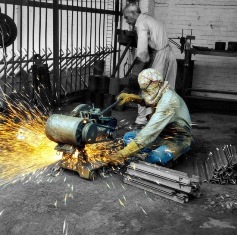
Handpump Technologies
Manual pumps have been used for centuries but this simple technology remains the mainstay of rural water supplies in many countries.
RWSN has maintained international standards for the public domain handpumps since 1992 and provided extensive technical support to many national governments, NGOs and the private sector to enable decisions to be made regarding handpump standardisation, raise manufacturing standards and build skills and systems to improve handpump operation and maintenance.
If you have a limited internet connection, then we have a flash drive with all the handpump specifications and manuals - contact the RWSN Secretariat on
The RWSN website hosts the standards, manufacturing and quality control guidelines, installation and maintenance manuals, as well as numerous studies for a wide range of handpumps in the overview below.
Are you new to the subject of handpumps?
If you want to learn about handpump technology, the handpumps most commonly used today, and how they came to dominate the market, and are interested in the current handpump challenges, we suggest that you start by reading the following documents:
|
Pump Technology and History |
Handpump challenges of today |
|
Other practical documents that you may not know about
RWSN has published maintenance manuals, and short maintenance cards for the following pumps:
- Afridev Handpump Maintenance Card (English, French & Portuguese)
- Installation and Maintenance Manual for the Afridev Handpump
- Installation and Maintenance Manual India Mark II Handpump
- India Mark II Major Maintenance Guide
- Installation and Maintenance Manual for Rope Pumps
- Maintenance Card for Rope Pump
And if you have not played top trumps (a card game that we used for training) on handpumps, try this – The Handpump Card Game!
Hand Pump Overview: see below
Application
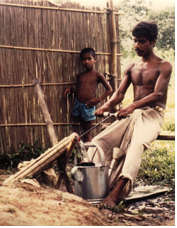 The Rower pump was developed as a simple manually operated pump for small scale irrigation. The Rower Pump is a suction pump in which the piston is directly activated. A surge chamber (an air vessel just downstream of the foot valve, makes the pumping op-eration is smoother). It is a simple and reliable pump with very few moving parts thus wear is reduced. It is easy to repair and main-tain The sitting position of the operator is ergonomically favourable and makes it easy to pump for prolonged periods, thus well suited for irrigation. The pump has limited use for drinking water as the spout is relatively low. Typically, Rower Pumps are installed in collapsible tube wells with the screen extending to the coarse sand aquifer.
The Rower pump was developed as a simple manually operated pump for small scale irrigation. The Rower Pump is a suction pump in which the piston is directly activated. A surge chamber (an air vessel just downstream of the foot valve, makes the pumping op-eration is smoother). It is a simple and reliable pump with very few moving parts thus wear is reduced. It is easy to repair and main-tain The sitting position of the operator is ergonomically favourable and makes it easy to pump for prolonged periods, thus well suited for irrigation. The pump has limited use for drinking water as the spout is relatively low. Typically, Rower Pumps are installed in collapsible tube wells with the screen extending to the coarse sand aquifer.
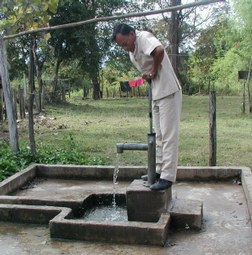 The Tara Pump is a “Direct Action Pump for Low Lift Wells”. It uses a buoyant pump rod that helps to reduce the forces on the handle. It is not designed for heavy-duty use, and can serve small communities of 100 persons. The maximum recommended lift is 15 m. The Tara Pump is a public domain pump defined by RWSN specifications and Indian Standards. It is fully corrosion resistant and is easy to install and has excellent potential for community-based maintenance.
The Tara Pump is a “Direct Action Pump for Low Lift Wells”. It uses a buoyant pump rod that helps to reduce the forces on the handle. It is not designed for heavy-duty use, and can serve small communities of 100 persons. The maximum recommended lift is 15 m. The Tara Pump is a public domain pump defined by RWSN specifications and Indian Standards. It is fully corrosion resistant and is easy to install and has excellent potential for community-based maintenance.
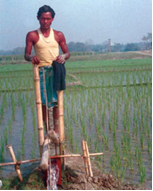 A pump for small scale irrigation and only limited use for drinking water.
A pump for small scale irrigation and only limited use for drinking water.
The treadle pump was developed as a simple foot operated pump for small scale irrigation. The pump is a suction pump in which the two pistons are activated via a pedal. The extended pedal acts as a counterpoise to push the piston back. The treadle pump is a simple and reliable pump with very few moving parts thus wear is reduced. It is easy to repair and maintain The stepping movement of the operator is ergonomically favourable and makes it easy to pump for prolonged periods, thus well suited for irrigation. The pump has limited use for drinking water as the spout is at ground level. Typically, Treadle pumps are installed in collapsible tube wells with the screen extending to the coarse sand aquifer.
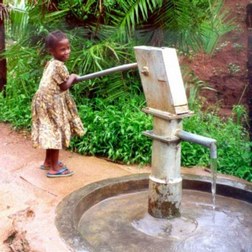 The U3M Pump is a conventional lever action handpump developed in Uganda. It is designed for heavy-duty use, serving communities of up to 300 persons. The maximum recommended lift is 45 m.
The U3M Pump is a conventional lever action handpump developed in Uganda. It is designed for heavy-duty use, serving communities of up to 300 persons. The maximum recommended lift is 45 m.
The U3M Pump is a public domain pump defined by RWSN specifications. The U3M Pump is fully corrosion resistant. It is easy to install and has excellent potential for community based maintenance.
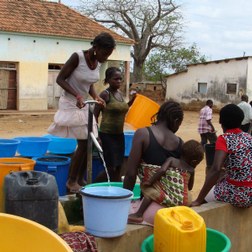 Vergnet Hydro is a commercial manual pump manufacturer based in France that uses a distinctive pumping mechanism where the piston movement is hydraulically transmitted via a flexible hose to a rubber diaphragm down in the pumping element. It is designed for heavy-duty use, serving communities of 300 people. The maximum recommended lift is 60 m (with one variant rated as suitable to 100m). The Vergnet pumps are fully corrosion resistant and installation of the pump is easy. Maintenance requirements are simple; above ground components allow interventions by the village caretaker, but below ground components are difficult to repair due to the precision engineering and specialist materials.
Vergnet Hydro is a commercial manual pump manufacturer based in France that uses a distinctive pumping mechanism where the piston movement is hydraulically transmitted via a flexible hose to a rubber diaphragm down in the pumping element. It is designed for heavy-duty use, serving communities of 300 people. The maximum recommended lift is 60 m (with one variant rated as suitable to 100m). The Vergnet pumps are fully corrosion resistant and installation of the pump is easy. Maintenance requirements are simple; above ground components allow interventions by the village caretaker, but below ground components are difficult to repair due to the precision engineering and specialist materials.
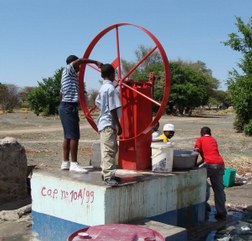 The Volanta Pump is a reciprocating pump for medium to very deep wells. It uses a retractable cylinder and a seal-less stainless steel piston. The stroke is adjustable to reduce the effort needed at deep installations. It is designed for heavy-duty use and the maximum recommended lift is 70 m.
The Volanta Pump is a reciprocating pump for medium to very deep wells. It uses a retractable cylinder and a seal-less stainless steel piston. The stroke is adjustable to reduce the effort needed at deep installations. It is designed for heavy-duty use and the maximum recommended lift is 70 m.
The Volanta Pump is not in the public domain and information can be asked from the manufacturer. The Volanta Pump is fully corrosion resistant. It is rather difficult to install and it needs extensive masonry work. Maintenance is easy so that communities can care for the pumps.
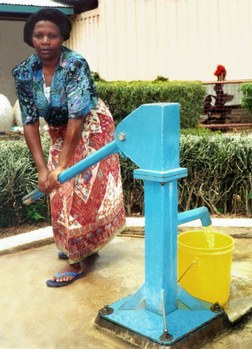 The Walimi Pump is a conventional lever action handpump for lifting water from low to medium deep wells. It is designed for small to medium sized communities of up to 250 persons. Besides the 3” (Ø76 mm) cylinder configuration, recommended to maximum lift of 25 m, a 2” version (Ø50 mm) cylinder is used for lifts up to 40 m. The Walimi Pump is a public domain pump defined by RWSN specifications. This pump is corrosion resistant, is quite easy to install and it has very good potential for community-based maintenance.
The Walimi Pump is a conventional lever action handpump for lifting water from low to medium deep wells. It is designed for small to medium sized communities of up to 250 persons. Besides the 3” (Ø76 mm) cylinder configuration, recommended to maximum lift of 25 m, a 2” version (Ø50 mm) cylinder is used for lifts up to 40 m. The Walimi Pump is a public domain pump defined by RWSN specifications. This pump is corrosion resistant, is quite easy to install and it has very good potential for community-based maintenance.
 Google Übersetzer
Google Übersetzer
